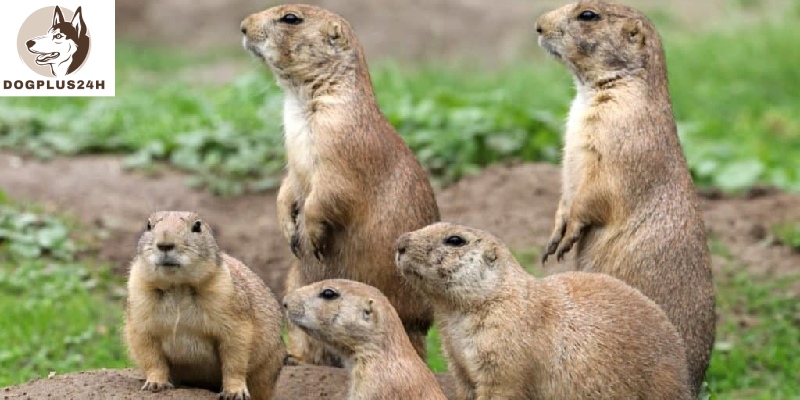Can you milk a prairie dog? It seems that this question stems from curiosity about how this organism interacts with the environment. In particular, this is how they nurture their young. However, to understand this, we need to go deeper into the biological structure of the prairie dog. This article will help you discover the interesting facts behind milking prairie dogs.
What is a prairie dog?
Prairie dogs can bark like dogs. That’s how they get their name, but these little dogs are rodents, not dogs.
These animals generally have a squirrel-like appearance. It is characterized by a small but stout body, round ears, a short tail, and strong claws. The short, coarse coat is golden brown with hints of brown and red. The tail is also covered with black, white, or gray fur. Weighing 1 to 4 pounds, prairie dogs are about the size of a rabbit. Its body measures 12 to 16 inches, while the tail adds 1 to 5 inches in length.

On average, males tend to be slightly larger than females, but their appearance is similar except for obvious sexual differences. And this mammal always makes time for its family. Family groups of prairie dogs, up to 26 individuals, share food, groom each other, and even greet each other by nuzzling each other.
Types of prairie dogs
Five species of prairie dogs currently exist:
Black-tailed prairie dog
It is named after the black tip of their tail. This rodent does not hibernate during the winter but instead falls into a coma when night falls.
Utah prairie dog
Their small size, colorful plumage, and black eyebrows set them apart. Due to their IUCN status as endangered, they are currently a protected species.
Mexican prairie dog
Native to Mexico, as its name suggests, this rodent is considered a pest and a hindrance to agriculture and livestock farming. As a result of eradication campaigns, the subspecies now occupies less than 4% of its former range.
Gunnison’s prairie dog
Recognizable by their typically light gray-tipped tail, these ground squirrels are also the only prairie dogs with 40 pairs of chromosomes. All other subspecies have 50 pairs.
White-tailed prairie dog
Its distinguishing features are black spots on the cheeks above and below both eyes and a white tail. This mammal lives at higher altitudes than its closest relatives.
What are the threats to prairie dogs?
These animals face many threats in the wild. It is always at risk of death from natural predators and even other prairie dogs.

But the main threat to its existence comes from human activity. The conversion of savannas into farmland, pastures, and towns has reduced the entire natural habitat of animals.
This is further exacerbated by the fact that many people consider them pests because of their destructive digging habits and deliberate hunting. It is estimated that they lost about 95% of their natural territory during the 20th century.
Another unexpected threat comes from the ancient scourge of the plague, which could devastate entire colonies and spread to other animals, including humans. Due to all of these threats, prairie dog populations have declined by about 98% from their peak. Can you milk a prairie dog? Continue reading the article.
Can you milk a prairie dog?
Can you milk a prairie dog? No, you cannot milk a prairie dog. Prairie dogs are small, burrowing rodents native to North America. Unlike mammals such as cows, goats, etc.
This strange belief seems to stem from the fact that female prairie dogs actually produce milk to feed their puppies. However, it is important to emphasize that prairie dogs do not produce milk in a way that is accessible to humans.
Mammals that can milk usually have mammary glands designed to produce and deliver milk to their offspring. Prairie dogs do not have the necessary anatomy to produce and secrete milk. Therefore, attempting to milk a prairie dog would be both biologically and ethically inappropriate.
The importance of milking for animals that can be milked
For humans
- Nutritional products: Milk is an important source of nutrients, including protein, fat, and micronutrients necessary for human development and maintenance of health.
- Health benefits: Milk provides calcium and vitamin D, which are necessary for the development and maintenance of healthy bones. It also contains ingredients that benefit the immune and digestive systems.
- Production of many other foods: Milk is used to produce many foods such as yogurt, butter, cheese, and many other products.
Nurturing animals’ offspring
- Nurturing phase: Milk is the ideal food for the young of animals that can be milked, providing important nutrients for development and strengthening their immune systems.
- Protect: Milk contains immune factors and antibodies that help protect the young from diseases and any potentially harmful bacteria or viruses.
- Build the relationship between mother and child: Expressing milk is a way to establish and strengthen the emotional bond between mother and child.
Can you milk a prairie dog? The answer is no. Prairie dogs are nothing like the cows and goats we have milked for centuries. This can hurt these tiny creatures and disrupt their natural lifestyle.

Alternatives to milk from other animals
Can you milk a prairie dog? Prairie dogs cannot be milked. Therefore, if you are looking for other animal-based milk alternatives, here are some suggestions.
- Soy Milk: Milk is produced from soybeans and water. It provides calcium and vitamin D.
- Almond Milk: The milk is made from almonds and water so it has a mild almond flavor. This product is rich in vitamin E and calcium.
- Coconut Milk: Milk is made from white coconut meat and water. It has a dense texture and is rich in saturated fat.
- Oat Milk: Milk is made from oat grains so it has a thick texture and natural sweetness. It provides fiber, B vitamins and minerals.
- Rice Milk: Milk is made from brown or white rice so it is naturally sweet, but often lower in protein.
- Flaxseed Milk: Milk is made from ground flaxseed and water. It provides a good source of omega-3 fatty acids and fiber.
It is essential to consider the ethical aspects of milk sourcing. Animal welfare, environmental impact and sustainability are important factors to consider when choosing milk. Choosing plant-based alternatives or ethically sourced animal milks may be more consistent with these considerations.
In conclusion
Can you milk a prairie dog? The idea of milking a prairie dog is certainly a good idea in books written about the field of exotic animal research. However, it is important to note that such initiatives are not only unfeasible but can also be dangerous for these creatures. Instead, let’s investigate the many milk sources that are accessible to us, keeping in mind ethical and environmental concerns.


